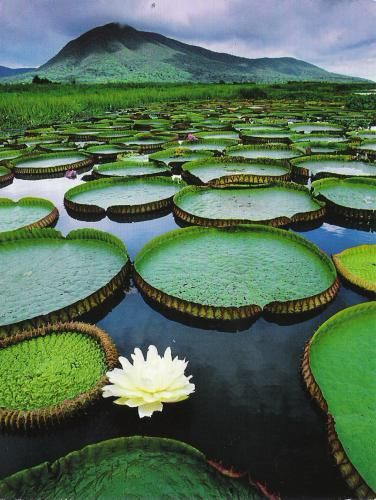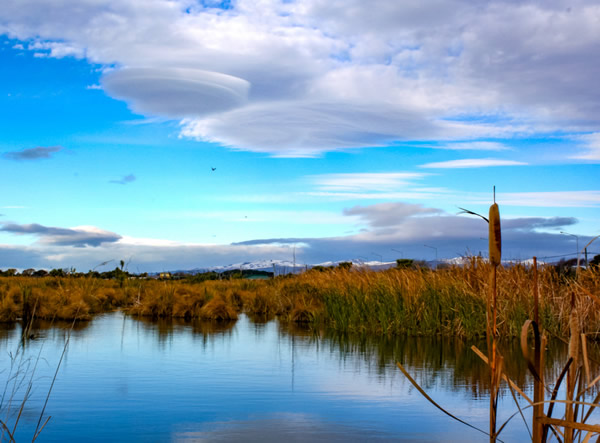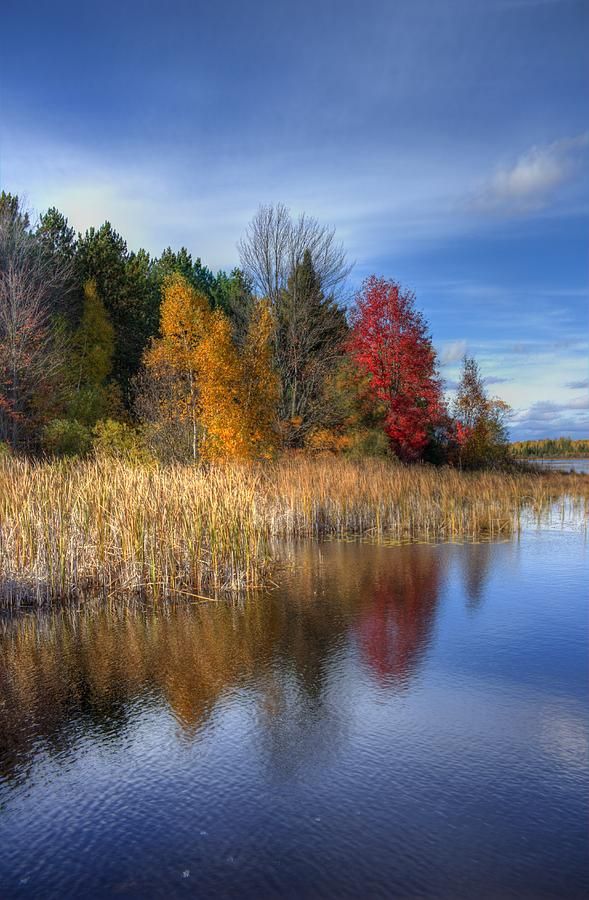 |
| Wetland life |
Wetlands, transitional areas between aquatic and terrestrial habitats, are home to a variety of flood-tolerant and salt-tolerant plant species.
Wetlands represent one of the most biologically unique and productive of all natural habitats. In their unaltered state, these water-influenced areas are used by a variety of wildlife species.
These habitats also have the ability to take up and store water during floods, and their soils and plants have the ability to remove nutrients and heavy metals from water.
The recognition of these values helped to slow the rate of wetlands loss to such uses as agricultural development and urban expansion. A desire to protect remaining wetland acres has led to a significant movement for wetlands preservation.
  |
Definition of Wetlands
Ecologists recognize wetlands as a type of ecotone. Ecotones are unique areas that represent a transition from one type of habitat to another. Often, these transitional areas have characteristics of both habitats. Wetlands are areas located between aquatic, water-based habitats and dry land.
Because they are located at the edge of an aquatic habitat, wetlands are always influenced to some degree by water. They are not always underwater, as are aquatic habitats, and they are not always dry, as are terrestrial habitats.
The most important environmental factor in wetlands is the periodic or frequent occurrence of water. This presence of water influences both the nature of the soil and the flora and fauna of a region.
Soils which experience periodic coverage with water become anoxic, develop a dark color, and give off an odor of hydrogen sulfide. These soil characteristics differ from those of upland soils and give wetland soils their unique hydric nature.
In these soils influenced by water, only flood-tolerant hydrophyte species can exist. Hydrophytic plants vary in their tolerance to flooding from frequent (such as bald cypress) to infrequent (such as willows).
In defining a particular area as a wetland, often all three of the components listed above are used: water, hydric soils, and hydrophytic plants.
However, the presence of water is not always a reliable indicator because water rarely covers a wetland at all times. Often, a wetland is dry during a period of low river flow or during a low tide. For this reason, only hydric soils and hydrophytic plants should be used as reliable indicators of a wetland.
Classification of Wetlands
 |
| Freshwater wetlands |
The broadest classification of wetlands includes two categories: freshwater and salt water wetlands. Freshwater wetlands occur inland at the edges of rivers, streams, lakes, and other depressions that regularly fill with rainwater. Saltwater wetlands occur along the coast in bays, where salt water and fresh water mix and wave energy is reduced.
Of the two categories, freshwater wetlands are by far the most common. Freshwater wetlands are subdivided into two categories: tree-dominated types and grass-dominated types.
Tree-dominated freshwater wetlands include areas that are frequently covered with water (such as cypress swamps) and those that are only occasionally covered with water (such as bottom land forests). Grass-dominated types include freshwater marshes, prairie potholes, and bogs.
While fresh water marshes are wide spread, prairie potholes and bogs occur regionally in the United States. Prairie potholes are located in the central portion of the United States, while bogs are found in the Northeast and Great Lakes regions.
   |
Saltwater wetlands are also subdivided into tree-dominated and grass-dominated types. Tree-dominated types include tropical mangrove swamps. Grass-dominated types can be further subdivided into salt marshes and brackish marshes. Salt marshes occur in bays along the coast where salt water and fresh water mix in almost equal proportions.
Brackish marshes occur farther inland than salt marshes do; their mix contains less seawater and more fresh water. Both grass-dominated types are common in bays along the Gulf of Mexico and the East Coast of the United States.
The Biota of Wetlands
The most noticeable feature of all wetlands is the abundance of plant life. A variety of plant species thrive in wetlands, but each occurs only in a particular kind of habitat.
Freshwater wetlands that are frequently flooded provide a favorable habitat for water-tolerant trees, such as bald cypress and water tupelo, and water-tolerant herbaceous plants, such as cattail, arrowhead, bulrush, spike rush, water lily, and duckweed.
 |
| The Biota of Wetlands |
Less frequently flooded freshwater areas support trees such as willow, cottonwood, water oak, water hickory, and red maple. Seawater areas in tropical bays favor the development of mangroves, while temperate bays favor the development of cord grass.
Wetland plants provide a habitat for a variety of animals. Cypress swamps and cattail marshes support a large assortment of animals, including alligators, ducks, crayfish, turtles, fish, frogs, muskrat, wading birds, and snakes.
Likewise, mangrove prop roots provide attachment sites for a variety of invertebrates and shelter for numerous small fish, while upper branches provide roosting and nesting sites for birds.
In salt marshes, mussels live among cord grass roots,while snails, fiddler crabs, oysters, and clapper rails live among plant stalks. When water covers cord grass at high tide, plant stalks shelter small fish, crabs, and shrimp seeking refuge from large predators.
The Value of Wetlands
 |
| The Value of Wetlands |
The amount of plant material produced in wetlands is higher than that produced in most aquatic and terrestrial habitats. This large amount of plant material supports an abundance of animal life, including commercially important species such as crayfish, ducks, fish, muskrat, shrimp, and crabs.
The biotic value of wetlands is well recognized, but it represents only a part of their total value. Wetlands provide “services” for other areas that often go unrecognized.
For example, fresh water wetlands are capable of storing large amounts of water during periods of heavy rainfall. This capability can be important in minimizing the impact of flooding downstream. Saltwater wetlands along coastlines are an effective barrier against storms and hurricanes.
These natural barriers hold back the force of winds, waves, and storm surges while protecting inland areas. Wetlands are also capable of increasing water quality through the trapping of sediment, uptake of nutrients, and retention of heavy metals.
Sediment trapping occurs when moving water is slowed enough by grass and trees to allow suspended sediment particles to settle. Wetland plants take up nutrients, such as nitrates and phosphates, from agricultural runoff and sewage.
For this reason, wetlands are used as a final treatment step for domestic sewage from some small cities. Wetland soils are capable of binding heavy metals, effectively removing these toxic materials from the water.
Wetlands Loss and Preservation
 |
| Wetland in autumn |
It is estimated that the United States once contained more than 200 million acres of wetlands. Less than half this amount remains today. Once considered wastelands, wetlands were prime targets for “improvement.” Extensive areas of freshwater wetlands and prairie potholes have been drained and filled for agricultural development.
Salt water wet lands have been replaced by urban or residential development and covered with dredge spoil.Wetlands loss rates have slowed, but an estimated 300,000 acres continue to be lost each year in the United States.
The loss of wetlands habitat threatens the survival of a number of animal species, including the whooping crane, American crocodile, Florida panther, manatee, Houston toad, snail kite, and wood stork.
Since the 1970’s the rate of wetlands loss has slowed for several reasons. One is the passage of federal and state laws designed to protect wetlands; another is the efforts of conservation organizations. At the federal level, the single most effective tool for wetlands preservation is Section 404 of the Clean Water Act.
Section 404 requires that a permit be issued before the release of dredge or fill material into U.S. waters, including wetlands. At the state level, Section 401 of the Clean Water Act allows states to restrict the release of dredge or fill material into wetlands.
There are several conservation organizations that support wetlands preservation, including Ducks Unlimited, the National Audubon Society, the National Wildlife Federation, and the Nature Conservancy. These organizations keep the public informed regarding wetlands issues and are active in wetlands acquisition.